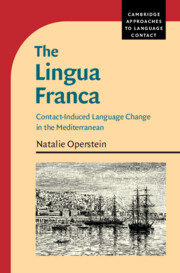Book contents
- The Lingua Franca
- Cambridge Approaches to Language Contact
- The Lingua Franca
- Copyright page
- Contents
- Tables
- Series Editor’s Foreword
- Abbreviations
- 1 Introduction
- 2 The Author
- 3 The Dictionnaire
- 4 The Orthography
- 5 The Lexicon
- 6 The Word Formation
- 7 The Inflection
- 8 The Syntax
- 9 The Lingua Franca
- Book part
- References
- Index
3 - The Dictionnaire
Published online by Cambridge University Press: 25 November 2021
- The Lingua Franca
- Cambridge Approaches to Language Contact
- The Lingua Franca
- Copyright page
- Contents
- Tables
- Series Editor’s Foreword
- Abbreviations
- 1 Introduction
- 2 The Author
- 3 The Dictionnaire
- 4 The Orthography
- 5 The Lexicon
- 6 The Word Formation
- 7 The Inflection
- 8 The Syntax
- 9 The Lingua Franca
- Book part
- References
- Index
Summary
The preceding chapter has substantiated the hypothesis that the basis for the Dictionnaire de la langue franque was laid by the diplomat scholar William B. Hodgson who conducted research on LF in Algiers. The present chapter develops our knowledge of the Dictionnaire’s sources by focusing on the publications which provided Hodgson with conceptual models for this work. Section 3.1 introduces two Italian grammars which were used as models for the Dictionnaire’s preface, LF dialogues, and Arabic vocabulary: Veneroni (1800) and Vergani (1823). Section 3.2 examines the use of the learner’s dialogues in Vergani (1823) as a model for the Dictionnaire’s dialogues in LF.
- Type
- Chapter
- Information
- The Lingua FrancaContact-Induced Language Change in the Mediterranean, pp. 37 - 105Publisher: Cambridge University PressPrint publication year: 2021

